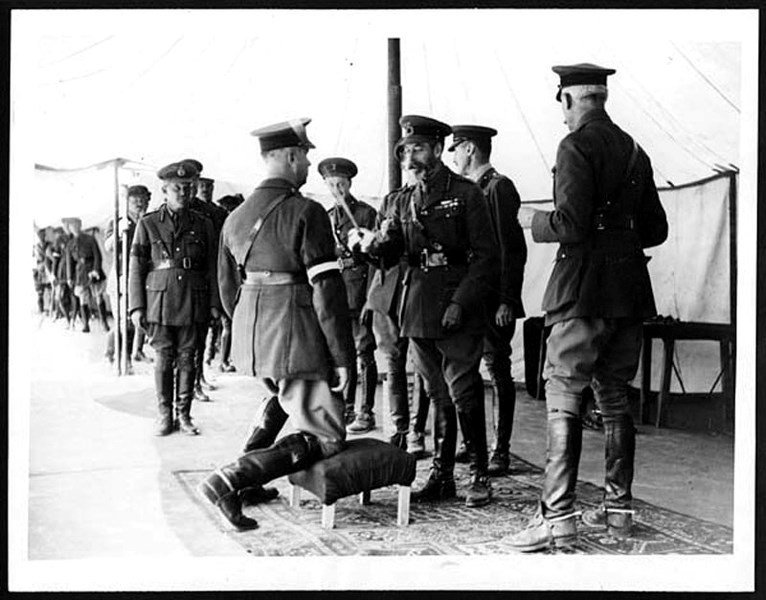If you're a fan of DC superhero comics, the real Arthur Currie is an entirely different character than who you're thinking of. Aquaman is not the focus of the new exhibit at the Musée Héritage Museum.
General Sir Arthur Currie is a true legend and was a defining presence during the First World War, including the Battle of Vimy Ridge.
It's one thing to start as a gunner on the bottom rung with no other hopes of climbing up the ladder. Instead, he rose up through the ranks to eventually become a more important figure on the world stage.
"He was the first Canadian who commanded the Canadian Forces in the First World War," said curator Joanne White. The only others to hold that position were senior British officers.
It's another thing entirely for him to be considered among the most capable commanders of the Western Front and one of the finest commanders in Canadian military history. His decorations include the Knight Grand Cross of the Order of St. Michael and St. George, the Knight Commander of the Order of the Bath, and Chevalier of France's Legion of Honour.
Furthermore, his aptitudes in adapting his military tactics on the battlefield led to him never losing a battle.
His military CV
Currie had aptitudes for the military life. He was first commissioned as an officer in 1900 and promoted to captain the year after that. He then became a major in 1906 and an artillery regimental commander in 1909.
The 50th Regiment Gordon Highlanders of Canada were created in 1913 and Currie accepted its first command post.
Although he found prowess leading troops and strategizing in army terms, private life didn't treat him so well. A real estate crash in British Columbia left him deep in debt, which he paid off after embezzling $10,000 that was earmarked for regimental uniforms.
Somehow, that was forgiven when the First World War began in 1914. The famous Canadian Minister of Militia Sam Hughes appointed him as Commander of the 2nd Canadian Brigade. Hughes' son Garnet worked hard to convince Currie to take the appointment despite his financial troubles.
During the Second Battle of Ypres, the brigade took control of a section of trench but German troops started to use poison gas for the first time in battle on the Western Front. French troops broke away from the Canadians' left flank and a seven-km gap opened up in the chaos. Currie's savvy and mettle were proved when he guessed at the source of the disruption.
He figured out a plan for defence and counterattack. The line was re-established after several days of fierce conflict and the German breakthrough was denied.
For this, he was promoted to Major General and became commander of the First Canadian Division, which would have a major role in the upcoming Battle of Arras. The Canadians were to attack Vimy Ridge and bring it back under Western control. Sir Julian Byng, then commander of the Canadian Corps, ordered Currie to study the Battle of the Somme and the Battle of Verdun and learn an appropriate strategy for Vimy.
Thanks to his acumen, he made organizational changes to the structure of the platoon. Those changes eventually spread across the entire army.
After the Battle of Vimy Ridge, Currie was promoted to Lieutenant-General and assumed command of the Canadian Corps. When he returned to Canada, he became a General and was made Inspector-General of the Canadian Army.
Not bad for a guy with only a high school diploma who once didn't think he'd ever make it past being a gunner. He earned the nickname 'Guts and Gaiters' because he wasn't a genial leader and the troops thought him aloof. Maybe if they could see his future successes, he might have been called 'Brains and Battle-ready'.
"He was a really important Canadian," White said.
Take that, Aquaman.
The local connection
While Currie himself never set foot in St. Albert, the exhibit does work to somewhat highlight his ties with local entrepreneur and military strategist Brigadier-General Raymond Brutinel who served under his command.
"We've been doing World War One anniversary things and he was involved in Vimy, but he was also Raymond Brutinel's commander, so we had that connection. They worked closely together," White said.
Brutinel was a multifaceted industrialist who once was the world affairs columnist and editor of Le Courrier de l'Ouest, Alberta's first French language newspaper. At various other times during his wide career paths, he also discovered vast coal deposits in an area of Alberta that became known as The Coal Branch and he pushed for the Edmonton Interurban Railway, a project that went far but eventually faltered.
Later, he used his inventive business and military tactical skills to be the driving force in the Canadian Motor Machine Gun Brigade, a major component of the First World War. For this, he became known as the Father of Modern Mechanized Warfare. The year after Vimy, Brigadier-General Brutinel commanded the Canadian Machine Gun Corps, which included 11 motor machine gun batteries, four machine gun battalions and nearly 9,000 soldiers.
His house was right at the peak of Green Grove Drive but that was many moons ago. The museum made him the focus of an exhibit three years ago.
"We've got some cases on Brutinel that we've brought out again," White said.
The exhibit
The Life and Legacy of General Sir Arthur Currie
Runs until Sunday, June 11
Musée Héritage Museum
St. Albert Place, 5 St. Anne St.
Call 780-459-1528 or visit www.museeheritage.ca for further details.




